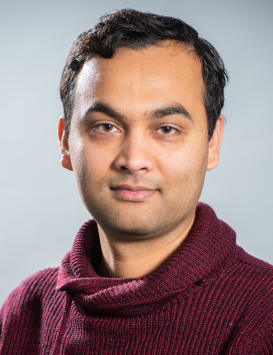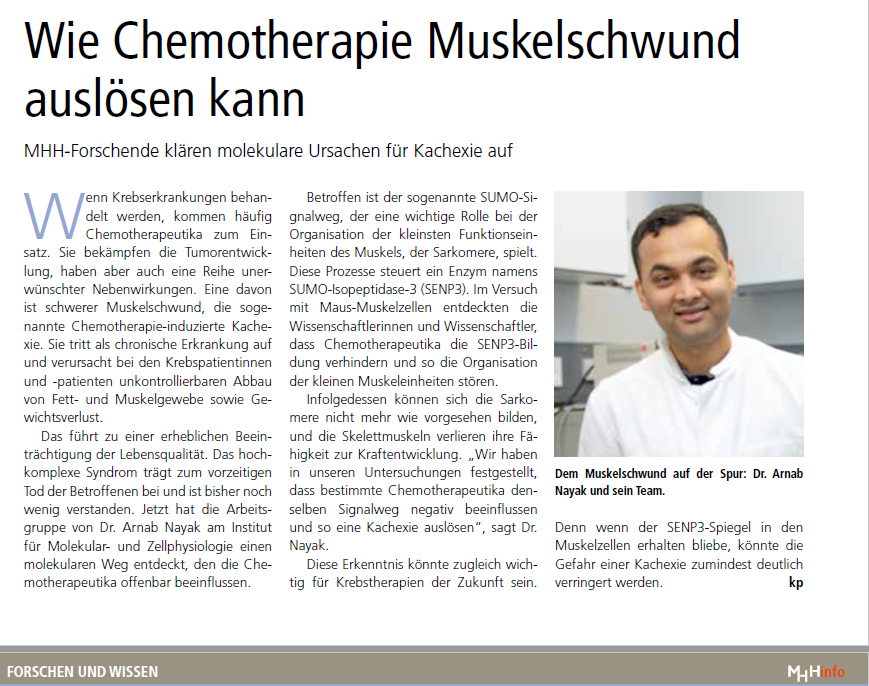Arnab Nayak
PD Dr. rer. nat.

Kontakt
► PD Dr. rer. nat. Arnab Nayak
Tel: +49 511 532 -2094 (Büro), -3654 (Labor)
Fax: +49 511 532-161215
Adresse: 30625 Hannover, Carl-Neuberg-Str.1
Büro: Gebäude J03, Block 01, Ebene 03, Raum 1340
ResearchGate: https://www.researchgate.net/profile/Arnab_Nayak
Lab webpage - https://www.mhh.de/mzp-group-nayak
AG Nayak
Zur Forschungsseite der Arbeitsgruppe

Werdegang
- 2023 Habilitation “Power of SUMO: Small Ubiquitin-like Modifier (SUMO) in Cellular Physiology and Pathophysiology”
Antrittsvorlesung - SUMO and Muscle : The mysterious cousin of ubiqitin „got the power” - 2017: Projektleiter der Chromatin- und SUMO-Physiologie-Arbeitsgruppe, Institut für Molekular- und Zellphysiologie, Medizinische Hochschule Hannover.
- 2011 - 2017: Postdoktorand an der Goethe-Universität Frankfurt.
- 2009 - 2011: Wissenschaftlicher Mitarbeiter, Universität Cambridge.
- 2008 - 2009: Career Development Fellow (CDF), MRC-LMB, Cambridge.
- 2004 - 2008: Promotion (PhD) an der Universität Würzburg.
- 2001 - 2003: Junior Research Fellow am National Centre for Cell Science (NCCS), Indien.
- 1999 - 2001: Master in Zoologie (Spezialisierung in molekularer, angewandter und klinischer Genetik) an der Banaras Hindu University, Indien.
- 1996 - 1999: Bachelor in Zoologie (mit Chemie und Botanik), Universität Burdwan, Indien.
Aktuelle Forschungsschwerpunkte
Zellbiologie, Kachexie, Chromatin & Epigenetik, Mitose, Molekulare Motorproteine, Proteomik, Stammzellen, SUMOylierung, Physiologie der quergestreiften Muskeln, Einzelmolekülstudien molekularer Motorproteine.
Förderung
Individual Research Grant- Deutsche Forschungsgemeinschaft (DFG).
Individual Research Grant- Deutsche Krebshilfe (DKH).
Ausgewählte wissenschaftliche Artikel in Fachzeitschriften (*Korrespondierender Autoren)
- Gand LV, Lanzuolo C, Li M, Rosti V, Weber N, Lu D, Bar C, Thum T, Pich A, Kraft T, Amrute-Nayak M, Nayak A* (2025) Calcium Handling Machinery and Sarcomere Assembly are Impaired Through Multipronged Mechanisms in Cancer Cytokine-Induced Cachexia. J Cachexia Sarcopenia Muscle 16: e13776
- Khan B, Lanzuolo C, Rosti V, Santarelli P, Pich A, Kraft T, Amrute-Nayak M, Nayak A* (2024) Sorafenib induces cachexia by impeding transcriptional signaling of the SET1/MLL complex on muscle-specific genes. iScience 27: 110913
- Wang T, Nayak A, Kraft T, Amrute-Nayak M (2024) Single-Molecule Investigation of Load-Dependent Actomyosin Dissociation Kinetics for Cardiac and Slow Skeletal Myosin. Small 20: e2406865
- Spahiu E, Uta P, Kraft T, Nayak A*, Amrute-Nayak M (2024) Influence of native thin filament type on the regulation of atrial and ventricular myosin motor activity. J Biol Chem 300: 107854
- Khan B, Gand LV, Amrute-Nayak M, Nayak A* (2023) Emerging Mechanisms of Skeletal Muscle Homeostasis and Cachexia: The SUMO Perspective. Cells 12
- Amrute-Nayak M, Gand LV, Khan B, Holler T, Kefalakes E, Kosanke M, Kraft T, Nayak A* (2022) SENP7 deSUMOylase-governed transcriptional program coordinates sarcomere assembly and is targeted in muscle atrophy. Cell Rep 41: 111702
- Wang T, Spahiu E, Osten J, Behrens F, Grunhagen F, Scholz T, Kraft T, Nayak A*, Amrute-Nayak M (2022) Cardiac ventricular myosin and slow skeletal myosin exhibit dissimilar chemomechanical properties despite bearing the same myosin heavy chain isoform. J Biol Chem 298: 102070
- Wang T, Brenner B, Nayak A*, Amrute-Nayak M (2020) Acto-Myosin Cross-Bridge Stiffness Depends on the Nucleotide State of Myosin II. Nano Lett 20: 7506-7512
- Amrute-Nayak M, Pegoli G, Holler T, Lopez-Davila AJ, Lanzuolo C, Nayak A* (2020) Chemotherapy triggers cachexia by deregulating synergetic function of histone-modifying enzymes. J Cachexia Sarcopenia Muscle
- Nayak A*, Amrute-Nayak M (2020) SUMO system - a key regulator in sarcomere organization. FEBS J 287: 2176-2190
- Nayak A, Wang T, Franz P, Steffen W, Chizhov I, Tsiavaliaris G, Amrute-Nayak M (2020) Single-molecule analysis reveals that regulatory light chains fine-tune skeletal myosin II function. J Biol Chem 295: 7046-7059
- Nayak A*, Lopez-Davila AJ, Kefalakes E, Holler T, Kraft T, Amrute-Nayak M (2019) Regulation of SETD7 Methyltransferase by SENP3 Is Crucial for Sarcomere Organization and Cachexia. Cell Rep 27: 2725-2736 e4
- Amrute-Nayak M, Nayak A, Steffen W, Tsiavaliaris G, Scholz T, Brenner B (2019) Transformation of the Nonprocessive Fast Skeletal Myosin II into a Processive Motor. Small 15: e1804313
- Nayak A*, Reck A, Morsczeck C, Muller S (2017) Flightless-I governs cell fate by recruiting the SUMO isopeptidase SENP3 to distinct HOX genes. Epigenetics Chromatin 10: 15
- Jung J, Nayak A, Schaeffer V, Starzetz T, Kirsch AK, Muller S, Dikic I, Mittelbronn M, Behrends C (2017) Multiplex image-based autophagy RNAi screening identifies SMCR8 as ULK1 kinase activity and gene expression regulator. Elife 6
- Brandes RP, Harenkamp S, Schurmann C, Josipovic I, Rashid B, Rezende F, Lowe O, Moll F, Epah J, Eresch J, Nayak A, Kopaliani I, Penski C, Mittelbronn M, Weissmann N, Schroder K (2016) The Cytosolic NADPH Oxidase Subunit NoxO1 Promotes an Endothelial Stalk Cell Phenotype. Arterioscler Thromb Vasc Biol 36: 1558-65
- Muller S, Nayak A* (2016) Inhibition of MLL1 histone methyltransferase brings the developmental clock back to naive pluripotency. Stem Cell Investig 3: 58
- Tamura N, Simon JE, Nayak A, Shenoy R, Hiroi N, Boilot V, Funahashi A, Draviam VM (2015) A proteomic study of mitotic phase-specific interactors of EB1 reveals a role for SXIP-mediated protein interactions in anaphase onset. Biol Open 4: 155-69
- Nayak A, Muller S (2014) SUMO-specific proteases/isopeptidases: SENPs and beyond. Genome Biol 15: 422
- Nayak A, Viale-Bouroncle S, Morsczeck C, Muller S (2014) The SUMO-specific isopeptidase SENP3 regulates MLL1/MLL2 methyltransferase complexes and controls osteogenic differentiation. Mol Cell 55: 47-58
- Raman N, Nayak A, Muller S (2014) mTOR signaling regulates nucleolar targeting of the SUMO-specific isopeptidase SENP3. Mol Cell Biol 34: 4474-84
- Raman N, Nayak A, Muller S (2013) The SUMO system: a master organizer of nuclear protein assemblies. Chromosoma 122: 475-85
- Nayak A, Glockner-Pagel J, Vaeth M, Schumann JE, Buttmann M, Bopp T, Schmitt E, Serfling E, Berberich-Siebelt F (2009) Sumoylation of the transcription factor NFATc1 leads to its subnuclear relocalization and interleukin-2 repression by histone deacetylase. J Biol Chem 284: 10935-46
- Schmidt D, Nayak A, Schumann JE, Schimpl A, Berberich I, Berberich-Siebelt F (2008) Blimp-1Deltaexon7: a naturally occurring Blimp-1 deletion mutant with auto-regulatory potential. Exp Cell Res 314: 3614-27
Preise
- Individuelle Forschungsförderung von DFG und DKH.
- Best talk Preise. 6th UCT science day Goethe University Frankfurt.
- Fritz Thyssen foundation research postdoc fellowship.
- Career Development Fellowship (CDF) Preise von MRC-LMB, Cambridge, UK.
- Best poster Preise, EMBO conference on chromatin and epigenetics EMBL, Heidelberg, Germany.
- Stipendium von Graduate School of Immunomodulation (Würzburg University) und Hannover Biomedical Research School (HBRS, MHH) Germany for doctoral studies.
- Junior Research Fellowship Preise by CSIR (Center for Scientific and Industrial Research)- NET (National Eligibility Test), India.
- GATE (Graduate Aptitude Test for Engineering) fellowship.
- Junior research fellowship by NCCS Pune, India.
- National Talent Search scholarship, India.
Eingeladene Vortragspräsentation auf internationalen Konferenzen
- Eingeladener render bei EMBO meeting in skeletal muscle development, metabolism, and repair during homeostasis and disease (October 2024, Sicily, Italy).
- Eingeladener Redner bei EMBO Konferenz (SUMOylation: From discovery to translation), Povoa de Varzim, Portugal (September 2023)
- Eingeladener Redner bei CCC-N (Comprehensive Cancer Center-Niedersachsen) (2022)
- 100th annual meeting of the German Physiological Society (DPG) (Frankfurt am Main, Germany, 2021)
- Gordon Research Konferenz (Kurzvortrag) über Myogenese, Lucca Italien (2019).
- Eingeladener Redner bei Indian Institute of Scientific Education & Research (IISER-Kolkata, 2018).
- Eingeladener Redner bei Internationaler Kongress für Epigenetik und Chromatin (Frankfurt, 2017).
- Eingeladener Redner bei Indian Institute of Scientific Education & Research (IISER-Pune, 2015)
- UCT Science Day Symposium (Goethe-Universität Frankfurt, 2014).
- DFG-Konferenz in Zeuthen (2013).
- Cambridge Cancer Centre meeting, Cambridge (UK, 2010).
- EMBO-Konferenz zu Chromatin und Epigenetik (EMBL Heidelberg 2007).
Kooperationspartner
- Dr. Chiara Luanzolo, Institut für Biomedizinische Technologien (ITB)-CNR, Labor für Chromatin und Nukleararchitektur am Istituto Nazionale di Genetica Molecolare "Romeo ed Enrica Invernizzi” Milano, Italien
- Prof. Riikka Kivela, Stem Cells and Metabolism Research Program, Faculty of Medicine. University of Helsinki, Finland. Faculty of Sport and Health Sciences. University of Jyväskylä, Finland
- Dr. Julien Gondin
Institut NeuroMyoGène (INMG) Physiopathologie et Génétique du Neurone et du Muscle (PGNM) UMR CNRS 5261 – INSERM U1315, Lyon, France. - Prof. Dr. med. Michael Heuser
Innere Medizin, Hämatologie / Onkologie. Universitätsmedizin Halle, Germany - Prof. Dr. Christian Bär
Institute of Molecular and Translational Therapeutic Strategies, Hannover Medical School, Germany
Lehre
- Praktika für Medizinstudierende (Humanmedizin und Zahnämedizin)
- Seminare für Medizinstudenten
- Praktika für Biologiestudenten
- Praxiskurse für Studierende des MSc „Biomedizin“.
- Doktorarbeiten in Biologie und Medizin
- 2012 - 2016 jährlich Leitung des Praktikums Biochemie für Studierende der Humanmedizin am Universitätsklinikum der Goethe-Universität Frankfurt.
- 2006 und 2007, Praktikum/Lehre T-Zell-Aktivierung und konfokale Mikroskopie an der Universität Würzburg.